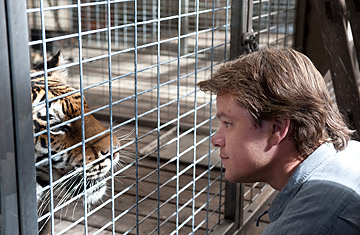
Matt Damon gets up close and personal with one of his new four-legged neighbors in We Bought a Zoo
It was one of the most horrifying animal stories of 2011. On Oct. 18, Terry Thompson of Zanesville, Ohio, set loose captive Bengal tigers — along with dozens of other exotic animals in his private menagerie — before taking his own life. As town residents cowered in fear, overmatched Ohio police were forced to kill nearly all the animals, including the 18 Bengal tigers. Sheriffs reported later that some of the tigers had been charging police as they were shot — attacks that surely would have been lethal for the humans.
Reporting on the aftermath of the tragedy, it became clear to me just how little regulation exists around such private zoos. Ohio is one of eight states in the U.S. that do not regulate exotic animals, so even though there had been several complaints about Thompson's personal wildlife collection leading up to the incident, police could do little about it. The U.S. Department of Agriculture conducts some inspections of private zoos if the animals are exhibited for the public, but even there, escapes and attacks on human beings are not rare. "No one can be sure that they can control a dangerous exotic animal," Tim Harrison, a former Ohio cop who runs the NGO Outreach for Animals, told me at the time. "That should be common sense — but common sense isn't always that common."
I thought about the Zanesville story again this holiday weekend as my family made its annual Christmas-night pilgrimage to the movies. Among the films on tap was the Cameron Crowe–directed family drama We Bought a Zoo, loosely based on the real-life story of a British journalist named Benjamin Mee, who — in the wake of his wife's illness and eventual death — makes the half-crazy decision to buy, fix up and reopen a zoo in rural England. Mee (played by Matt Damon) has zero experience with wild animals before he takes over his own menagerie, but in Crowe's world, that's O.K. "You don't need any special knowledge to run a zoo," Mee says in the film. "What you need is a lot of heart."
I imagine the professionals at the San Diego Zoo or the National Zoo in Washington might want to point out that, in fact, special knowledge — and perhaps even a graduate degree — is, indeed, useful for running a zoo. But my trouble with films like We Bought a Zoo goes beyond the treacly script and the inevitable montages scored to Peter Gabriel tunes. Just as the Zanesville tragedy raised questions about the safety of owning exotic animals like tigers and chimpanzees, some animal-rights groups have taken We Bought a Zoo to task for putting scores of wild animals to work in the movie — and glorifying private zoos along the way. "The messages coming out of these kinds of movies is very disappointing," says Julia Gallucci, a primatologist with People for the Ethical Treatment of Animals.
It's true that life is better for animals in Hollywood now than it once was. Nonhuman actors were once considered as expendable as the scenery. To get footage of a cowboy on horseback jumping into a lake for the 1939 Henry Fonda film Jesse James, filmmakers pushed a blindfolded horse off a high cliff; the animal suffered a broken back and had to be destroyed. That episode — along with other tales of cruelty on set — helped get the American Humane Association (AHA) involved in Hollywood, and in 1980 the film industry's rules were amended to include regulations requiring proper treatment of animals. The agreement allowed AHA representatives on set — though only at the discretion of the industry — and gave birth to the famous "No animals were harmed in the making of this film" end credit.
But even with AHA experts present, accidents and abuse can happen. A giraffe died on set during the filming of the 2011 comedy Zookeeper, and activists have charged that trainers on set abused an elephant appearing in the Robert Pattinson drama Water for Elephants. (The trainers denied the charges.) The interspecies clashes may be due to the fact that wild animals — as opposed to domestic animals like dogs or horses — are not meant to perform with human beings, or even safely coexist with them, and need to be coerced to do so. "When you deal with tigers and elephants and chimps, these are animals who are dangerous, and their instinctive behavior can cause them to maim or kill human beings," says Gallucci. "It's who they are."
Each year, there are accidents involving private collections of exotic animals — too often fatal. It's not just lions or tigers; in 2009, a 200-lb. (90 kg) pet chimp named Travis broke loose and badly mauled a local woman in Connecticut before he was put down by police. Mee's original memoir contains more than a few hair-raising scenes involving near escapes by dangerous animals — including a jaguar named Sovereign. Fortunately, neither people nor the animals were hurt in these incidents, and Mee treats them as a bit of a lark, but things could have easily gone much worse — as they did at the San Francisco Zoo in 2007, when a 300-lb. (136 kg) tiger escaped from its cage and killed a visitor.
As it happens, AHA reps were on the scene for the filming of We Bought a Zoo, and the movie received the group's highest safety rating — even the bees used for one scene were well taken care of. But to me the issue isn't so much what's happening on movie sets, as the message the films are sending. Zoos aren't something anyone with a dollar and a dream should be running, and wild animals shouldn't be used for our entertainment. Lions and tigers and chimps aren't actors, even if we put them in Hollywood. It's not who they are.
